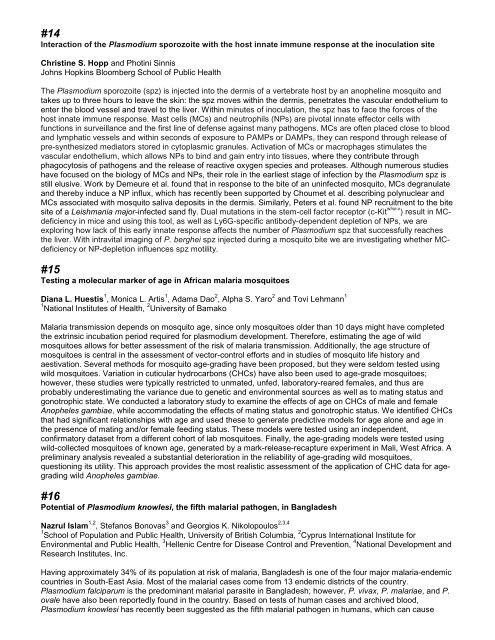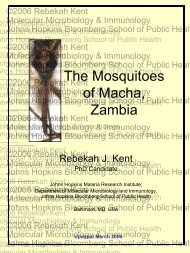Conference Program - Johns Hopkins Malaria Research Institute ...
Conference Program - Johns Hopkins Malaria Research Institute ...
Conference Program - Johns Hopkins Malaria Research Institute ...
Create successful ePaper yourself
Turn your PDF publications into a flip-book with our unique Google optimized e-Paper software.
#14<br />
Interaction of the Plasmodium sporozoite with the host innate immune response at the inoculation site<br />
Christine S. Hopp and Photini Sinnis<br />
<strong>Johns</strong> <strong>Hopkins</strong> Bloomberg School of Public Health<br />
The Plasmodium sporozoite (spz) is injected into the dermis of a vertebrate host by an anopheline mosquito and<br />
takes up to three hours to leave the skin: the spz moves within the dermis, penetrates the vascular endothelium to<br />
enter the blood vessel and travel to the liver. Within minutes of inoculation, the spz has to face the forces of the<br />
host innate immune response. Mast cells (MCs) and neutrophils (NPs) are pivotal innate effector cells with<br />
functions in surveillance and the first line of defense against many pathogens. MCs are often placed close to blood<br />
and lymphatic vessels and within seconds of exposure to PAMPs or DAMPs, they can respond through release of<br />
pre-synthesized mediators stored in cytoplasmic granules. Activation of MCs or macrophages stimulates the<br />
vascular endothelium, which allows NPs to bind and gain entry into tissues, where they contribute through<br />
phagocytosis of pathogens and the release of reactive oxygen species and proteases. Although numerous studies<br />
have focused on the biology of MCs and NPs, their role in the earliest stage of infection by the Plasmodium spz is<br />
still elusive. Work by Demeure et al. found that in response to the bite of an uninfected mosquito, MCs degranulate<br />
and thereby induce a NP influx, which has recently been supported by Choumet et al. describing polynuclear and<br />
MCs associated with mosquito saliva deposits in the dermis. Similarly, Peters et al. found NP recruitment to the bite<br />
site of a Leishmania major-infected sand fly. Dual mutations in the stem-cell factor receptor (c-Kit w/w-v ) result in MCdeficiency<br />
in mice and using this tool, as well as Ly6G-specific antibody-dependent depletion of NPs, we are<br />
exploring how lack of this early innate response affects the number of Plasmodium spz that successfully reaches<br />
the liver. With intravital imaging of P. berghei spz injected during a mosquito bite we are investigating whether MCdeficiency<br />
or NP-depletion influences spz motility.<br />
#15<br />
Testing a molecular marker of age in African malaria mosquitoes<br />
Diana L. Huestis 1 , Monica L. Artis 1 , Adama Dao 2 , Alpha S. Yaro 2 and Tovi Lehmann 1<br />
1 National <strong>Institute</strong>s of Health, 2 University of Bamako<br />
<strong>Malaria</strong> transmission depends on mosquito age, since only mosquitoes older than 10 days might have completed<br />
the extrinsic incubation period required for plasmodium development. Therefore, estimating the age of wild<br />
mosquitoes allows for better assessment of the risk of malaria transmission. Additionally, the age structure of<br />
mosquitoes is central in the assessment of vector-control efforts and in studies of mosquito life history and<br />
aestivation. Several methods for mosquito age-grading have been proposed, but they were seldom tested using<br />
wild mosquitoes. Variation in cuticular hydrocarbons (CHCs) have also been used to age-grade mosquitoes;<br />
however, these studies were typically restricted to unmated, unfed, laboratory-reared females, and thus are<br />
probably underestimating the variance due to genetic and environmental sources as well as to mating status and<br />
gonotrophic state. We conducted a laboratory study to examine the effects of age on CHCs of male and female<br />
Anopheles gambiae, while accommodating the effects of mating status and gonotrophic status. We identified CHCs<br />
that had significant relationships with age and used these to generate predictive models for age alone and age in<br />
the presence of mating and/or female feeding status. These models were tested using an independent,<br />
confirmatory dataset from a different cohort of lab mosquitoes. Finally, the age-grading models were tested using<br />
wild-collected mosquitoes of known age, generated by a mark-release-recapture experiment in Mali, West Africa. A<br />
preliminary analysis revealed a substantial deterioration in the reliability of age-grading wild mosquitoes,<br />
questioning its utility. This approach provides the most realistic assessment of the application of CHC data for agegrading<br />
wild Anopheles gambiae.<br />
#16<br />
Potential of Plasmodium knowlesi, the fifth malarial pathogen, in Bangladesh<br />
Nazrul Islam 1,2 , Stefanos Bonovas 3 and Georgios K. Nikolopoulos 2,3,4<br />
1 School of Population and Public Health, University of British Columbia, 2 Cyprus International <strong>Institute</strong> for<br />
Environmental and Public Health, 3 Hellenic Centre for Disease Control and Prevention, 4 National Development and<br />
<strong>Research</strong> <strong>Institute</strong>s, Inc.<br />
Having approximately 34% of its population at risk of malaria, Bangladesh is one of the four major malaria-endemic<br />
countries in South-East Asia. Most of the malarial cases come from 13 endemic districts of the country.<br />
Plasmodium falciparum is the predominant malarial parasite in Bangladesh; however, P. vivax, P. malariae, and P.<br />
ovale have also been reportedly found in the country. Based on tests of human cases and archived blood,<br />
Plasmodium knowlesi has recently been suggested as the fifth malarial pathogen in humans, which can cause



